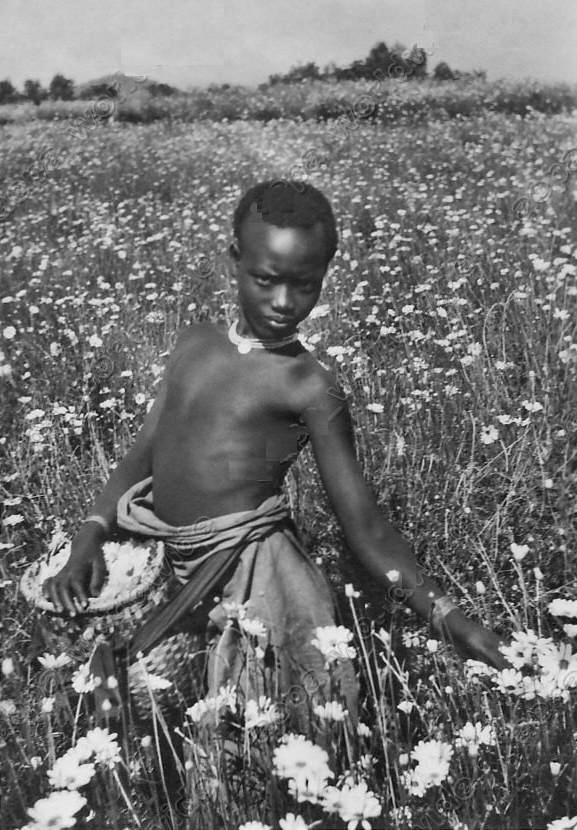
Figure 1.-- This Rwandan boy is gathering Chyrsantrumum flowers whih are used to make pyrethrum (an insecticide). The photograph is undated, but looks to be made during the colonial era, perhps the 1940s. |

|
Rwanda is a small East African country east of Zaire and Kake Kivu. The country in contrast to much of East Africa is well watered with lush vegetation. Thec teraine is undulating smll hills, known as the 'the land of a Thousand Hills". Much of it has been turned into small farms and tea plantations. It is perhaps best known as the home of some of the few surviving Mountain Gorillas, a third of Africa's birds spicies, and several other primates. There are volcanoes and game reserves. The climate is mild and temperate with two rainy seasons. Agriculture dominates the economy. Major crops include -coffee, tea, pyrethrum (insecticide made from chrysanthemums), bananas, beans, sorghum, potatoes, and livestock.
Industry includes cement, agricultural products, beer production, soft drinks, soap, furniture, shoes, plastic goods, textiles, cigarettes, and pharmaceuticals. The population is primarily Hutus, but the minotity Tutsis have dominated society. Rwanda was a Belgian colony, but administrered separately from the Belgian Congo (Zaire). The population is largely Roman Catholic. the Hutus as the colony was moving toward independecne, rose up to overthrow the Tutsis (1959). Many Tutsis were killed and some 150,000 fled nto exile in neighboring countries. Belgium granted Rawnda independence shortly after leaving the Congo (1962). Simmering tribal tensions let to the Rawanda genocide (1994). Some such events like the NAZI genocide of Jews were very difficult to stop, The Rawandan genocide, however, coukd have been stopped with a relatively small force. The world, however, failed to react. And in only a few months, the Hutu majority murdered an estimated 1 million Tutsis. We do not yet have much information on Rwanda, but do have a school page.
Rwanda is a small East African country east of Zaire and Kake Kivu. The country in contrast to much of East Africa is well watered with lush vegetation. Thec teraine is undulating smll hills, known as the 'the land of a Thousand Hills". Much of it has been turned into small farms and tea plantations. It is perhaps best known as the home of some of the few surviving Mountain Gorillas, a third of Africa's birds spicies, and several other primates. There are volcanoes and game reserves. The climate is mild and temperate with two rainy seasons.
Anthropologists believe that human occupation of Rwanda probably began after the last ice age. But there is little archaeological evience. The modern history of Rwanda began with the Twa, a Pygmy hunter-gather tribe. The Hutu, a more advanced agricultural people, appeared in the area (7th century). They were a Bantu people, probably migrating for better land from the central Congo basin. They displaced the Twa who retreated into remote jungle areas. The Hutu dominted the area (10th century). Gradually the Tutsi people, a tall cattle-rearing population, from the upper reaches of the Nile migrated into the areas and established dominance over the resident, less militarily organized, Hutu people who were mostly agriculturists. Gradually a number of small kingdoms or chiefdoms began to organize (16th century). King (Mwami) Rwabugiri, a Tutsi, began a decades-long military conquest of the smaller kingdoms (1860). He became essentially the King of Rwanda (late-19th century). His administrative consolidation resulted in his gaining control over most of modern Rwanda. This occured at a time that the European Scrable for Africa was underway. The solated highlands of Rwanda and Burundi, east of Lake Kivu, was the last little piece of Africa to be reached by Europeans--except for Ethiopia which resised European colonization. The colonial powers, first Germany and then Belgium after World War I, as aay of facilitating their administration allied with the Rwandan Tutsi court. Rwanda became part of the Belgian colony of Rwnda-Burundi which bordered on the much larger Belgian Congo. Rwanda after World War II proceeded toward independence as part of not only anti-colonial, but also anti-Tutsi sentiment. Belgium granting national independence (1961). The United Nations sponsored elections in that same year. The current government of Rwanda took power (1962). Grégoire Kayibanda led Rwanda's struggle for independence from Belgium, and replaced the Tutsi monarchy with a republican form of government. The U.N. regonized the Repunic of Rawnda (1962). He asserted Hutu majority power. Unsettled ethnic and political tensions were worsened when Juvénal Habyarimana, who was also Hutu, seized power (1973). The rebel Rwandan Patriotic Front (RPF) with 10,000 Tutsi refugees from previous decades of unrest, invaded the Rwanda launching the Rwandan Civil War. The war progressed, agrevating ethnic tensions, and more and more Hutus feared losing their democratic gains. Te tragic outcome was the Rwandan Genocide. The Hutu majority rose up and slaughtered more than 0.8 million Rwandans during a horific 100-day period (April 7 to mid-July 1994). Some 70 percent of the Tutsi population was killed along with 30 percent the Pygmy Batwa.
Agriculture dominates the economy. Major crops include -coffee, tea, pyrethrum (insecticide made from chrysanthemums), bananas, beans, sorghum, potatoes, and livestock. Industry includes cement, agricultural products, beer production, soft drinks, soap, furniture, shoes, plastic goods, textiles, cigarettes, and pharmaceuticals.
The population is primarily Hutus, but the minotity Tutsis have dominated society. Rwanda was a Belgian colony, but administrered separately from the Belgian Congo (Zaire).
We do not yet have much information on Rwandan activities, but do have a school page.
The population is largely Roman Catholic.
Navigate the Boys' Historical Clothing Web Site:
[Introduction]
[Activities]
[Biographies]
[Chronology]
[Cloth and textiles]
[Clothing styles]
[Countries]
[Topics]
[Bibliographies]
[Contributions]
[FAQs]
[Glossaries]
[Images]
[Links]
[Registration]
[Tools]
[Boys' Clothing Home]
Navigate the Boys' Historical Clothing national pages:
[Return to the Main African country page]
[Return to the Main African page]
[Angola]
[Cape Verde Islands]
[Democratic Republic of the Congo]
[Gabon]
[Lessotho]
[Madagascar]
[Mali]
[\
]South Africa]
[Uganda]
[Zaire/Congo]
[Belgiuml]
